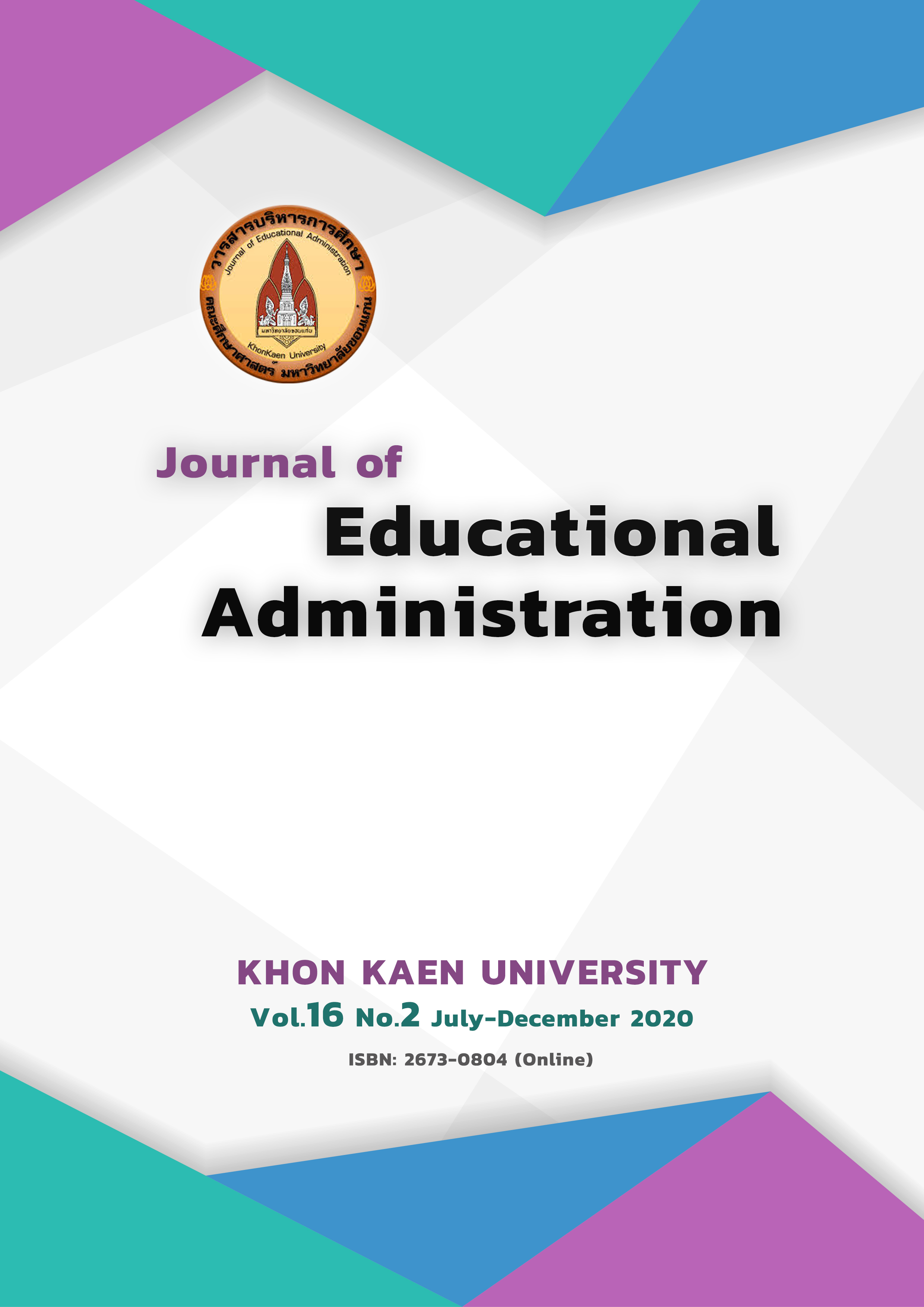ENVIRONMENT ANALYSIS, NEED AND GUIDELINES FOR SCHOOL MANAGEMENT OF REMOTE HIGHLAND AREAS
Main Article Content
Abstract
The objective of this research was to study the environment analysis, need, and guidelines for school management of remote highland areas. The samples used in the research were 361 persons; school administrators and teachers by multi-stage sampling. The research instruments were questionnaires and interviews. There were the questionnaires with the IOC between 0.80-1.00, and the reliability was 0.97. The SPSS for Windows package was used to measure data analysis. The statistics used consisted of percentage, mean, and standard deviation and content analysis.
The results revealed that;
- The environment of the school management of remote highlands areas found that the strength was the precise structure of school management. The weakness is that teachers had heavy workloads, both teaching and supporting affairs. Opportunities were external organizations to promote and support by applying modern digital technology in educational management. The obstacles were that most students were ethnic groups with different beliefs and values. The family was poor. Parents were doing subsistence agriculture.
- The need of school management of remote highlands areas had five aspects: academic, personnel, planning and budget, general management and royal projects found that the overall image was at a high level when considering each aspect, it was investigated that the aspect with the highest mean was personnel.
- Guidelines of school management of remote highlands areas found that 1) adjust the curriculum structures to be in line with the context of educational institutions 2) opening classroom branches in remote villages 3) adopting information technology media in teaching and learning management 4) building a network of partners for participation in educational development 5) increasing subsidies for individual, and additional expenses for boarding students 6) making an agreement with the higher educational institution to organize student teachers 7) increasing the living expenses, compensation for personnel 8) establishing criteria for the promotion of school teachers to a specific time, and 9) developing a system for helping students.
Article Details
References
กระทรวงศึกษาธิการ. (2559). การพัฒนารูปแบบการจัดการศึกษาสำหรับผู้ด้อยโอกาสในเขตพื้นที่สูงและถิ่น
ทุรกันดาร สังกัดสำนักงานคณะกรรมการการศึกษาขั้นพื้นฐานกระทรวงศึกษาธิการ. ศูนย์พัฒนา
คุณภาพการศึกษาด้วยเทคโนโลยีการศึกษาทางไกล. กรุงเทพฯ.
กระทรวงศึกษาธิการ. (2545). พระราชบัญญัติการศึกษาแห่งชาติ พุทธศักราช 2542 (ฉบับที่ 2) และที่แก้ไข
เพิ่มเติมพุทธศักราช 2545. กรุงเทพฯ: บริษัทสยามสปอรต์ ซินดิเค จำกัด.
กัญญาพัชร พงษ์ดี (2559). กลยุมธ์การบริหารแบบมีส่วนร่วมของไตรภาคีในการยกระดับคุณภาพผู้เรียนในโรงเรียน
พื้นที่สูงภาคเหนือตอนบน. วารสารมนุษยศาสตร์และสังคมศาสตร์ บัณฑิตวิทยาลัย มหาวิทยาลัยราชภัฏพิบูลสงคราม, 10(1), 162-179.
โครงการสมเด็จพระเทพรัตนราชสุดาฯ สยามบรมราชกุมารี. (2559). สำนักงาน . บทสรุปแผนพัฒนาเด็กและ
เยาวชนในถิ่นทุรกันดาร. ฉบับที่ 4 พ.ศ.2550 – 2559.
ประจวบ หนูเลี่ยง. (2559) . พัฒนารูปแบบการจัดการศึกษา แบบมีส่วนร่วมของจังหวัดพัทลุง. วารสารปาริชาต
มหาวิทยาลัยทักษิณ, 28(2), 232-253.
มานิตย์ แก้วกันธะ. (2558). การบริหารสถานศึกษาบนพื้นที่สูงที่มีนักเรียนหลายชนเผ่าเรียนรวมกัน สังกัดสำนักงานเขต
พื้นที่การศึกษาประถมศึกษาจังหวัดเชียงราย. วารสารศึกษาศาสตร์ มหาวิทยาลัยขอนแก่น, 9(2),
-114.
เพ็ญนภา ดีชัยยะ .(2554). ความรับผิดชอบต่อสังคมของธุรกิจในฐานบรรทัดฐานทางสังคมในบริบทโลกาภิวัฒน์
กรณีศึกษา นิคมอุตสาหกรรมมาบตาพุด. วิทยานิพนธ์ปริญญาศิลปศาสตรมหาบัณฑิต บัณฑิตวิทยาลัย จุฬาลงกรณ์มหาวิทยาลัย.
มนต์นภัส มโนการณ์ . (2560). การสังเคราะห์การจัดการศึกษาขั้นพื้นฐานบนพื้นที่สูงและทุรกันดาร. วารสาร
วิชาการศึกษาศาสตร์ คณะศึกษาศาสตร์ มหาวิทยาลัยศรีนครินทรวิโรฒ, 18(1), 70-82.
สมพิศ กาติ๊บ. (2557). กลยุทธ์การบริหารโรงเรียนในเขตพื้นที่ภูเขาสูงภาคเหนือตอนบน. วิทยานิพนธ์ปริญญา
ปรัชญาดุษฎีบัณฑิต สาขาวิชาการบริหารการศึกษา บัณฑิตวิทยาลัย มหาวิทยาลัยราชภัฏเชียงราย.
สมชาย อังสุโชติเมธี. (2562). รูปแบบการพัฒนาครูผู้สอนของสถานศึกษาขั้นพื้นฐานในเขตพื้นที่สูงสังกัด
สำนักงาน คณะกรรมการการศึกษาขั้นพื้นฐาน กระทรวงศึกษาธิการ. คณะศึกษาศาสตร์ วิทยาลัย
นอร์ทเทิร์น จังหวัดตาก.
สมยศ นาวีการ. (2551). การบริหารเชิงกลยุทธ์. กรุงเทพฯ: อักษรไทย.
สยาม เรืองสุกใสย์. (2560). “วิธีปฏิบัติที่ดี” พื้นที่สูงโมเดลกับการพัฒนาคุณภาพการศึกษาสำหรับนักเรียน
ด้อยโอกาสบนพื้นที่สูง โรงเรียนล่องแพวิทยา. สังกัดสำนักงานเขตพื้นที่การศึกษาประถมศึกษา
แม่ฮ่องสอนเขต 2.
สันติ บูรณะชาติ. (2561). กลยุทธ์การบริหารจัดการของสถานศึกษาขั้นพื้นฐานในบริบทสังคมพหุวัฒนธรรม
จังหวัดพะเยา. สาขาวิชาการศึกษา วิทยาลัยการศึกษา มหาวิทยาลัยพะเยา.
สำนักงานคณะกรรมการการศึกษาขั้นพื้นฐาน. (2559). การพัฒนาการศึกษาในพื้นที่ภูเขาสูงและทุรกันดาร.
กรุงเทพฯ: สำนักงานคณะกรรมการการศึกษาขั้นพื้นฐาน.
อโณทัย ไทยวรรณศรี และคณะ. (2559). รูปแบบการพัฒนาครูผู้สอนของสถานศึกษาขั้นพื้นฐานในเขตพื้นที่สูง
สังกัดสำนักงานคณะกรรมการการศึกษาขั้นพื้นฐาน กระทรวงศึกษาธิการ.
เอกชัย บุญยาธิษฐาน. (2553). คู่มือวิเคราะห์ SWOT อย่างมืออาชีพ. กรุงเทพฯ: สำนักพิมพ์ปัญญาชน.
Allen, N. J., & Meyer, J. P. (1990). The measurement and antecedents of affective, continuance, And normative
commitment to the organization. Journal Of Occupational Psychology, 63(10), 1-18.
Bank, James A. and Cherry A. McGee Banks. (2001). Multicultural Education: issues and Perspectives
(4th ed). New York: John Wiley & Sons.
Cronk, C.,Crocker, A.C.,& Pueschel, S.M. (1994). Human Resume Management. South Melbourne: Thomas
Nelson.


